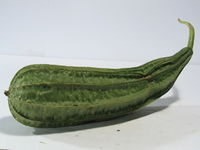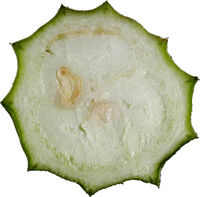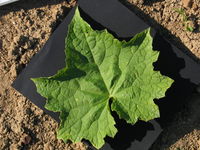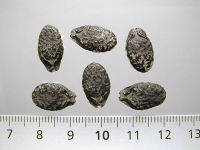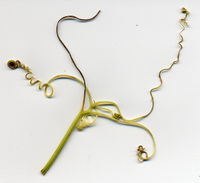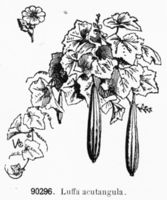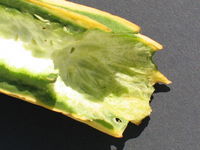Luffa acutangula
De PlantUse Français
Luffa acutangula (L.) Roxb.
| Ordre | Cucurbitales |
|---|---|
| Famille | Cucurbitaceae |
| Genre | Luffa |
2n = 26
Origine : Inde
sauvage ou cultivé
| Français | papengaye |
|---|---|
| Anglais | ridged gourd |
Résumé des usages
- pousses et fruit immature consommés comme légume
Sommaire
Description
Noms populaires
| français | papangaye, pipangaye |
| anglais | ridged gourd, angled loofah, Chinese okra |
| allemand | Flügelgurke |
| espagnol | calabaza de aristas, estropajo |
| portugais | lufa riscada, bucha de purga |
| hindi | kali turaī, kali tori, jhinga tori |
| tamoul | pikunkai, pirkankai, pīrkku |
| chinois | sī guā, léng jiǎo sī guā |
| Philippines | patola (tagalog), kabatiti (ilocano), buyo-buyo (bisaya) (PROSEA) |
| Indonésie | oyong, gambas (javanais), petola (PROSEA) |
| Malaysia | ketola, petola sagi (PROSEA) |
| Thaïlande | buap, buap-liam (central), manoi-liam (nord) (PROSEA) |
| Vietnam | mướp khía, mướp tâù (PROSEA) |
| Laos | looy (PROSEA) |
| Cambodge | ronôông chrung (PROSEA) |
Classification
Luffa acutangula (L.) Roxb. (1814)
basionyme :
- Cucumis acutangulus L. (1753)
Cultivars
Histoire
Usages
Le fruit jeune est comestible cru ou cuit, au champ même les lapins l’apprécient.
Références
- Chauvet, Michel, 2018. Encyclopédie des plantes alimentaires. Paris, Belin. 880 p. (p. 231)
- Dhillon, Narinder P. S. et al., 2016. Gourds: Bitter, Bottle, Wax, Snake, Sponge and Ridge. In: Grumet, R., Katzir, N., & Garcia-Mas, J., (eds). Genetics and Genomics of Cucurbitaceae. Plant Genetics and Genomics: Crops and Models, vol 20. Springer. 155-172. doi : 10.1007/7397_2016_24

